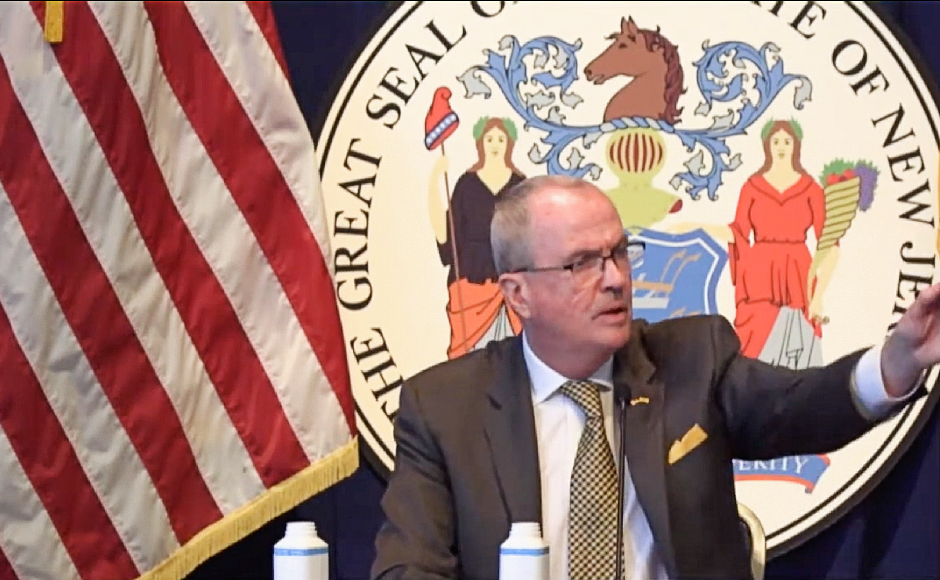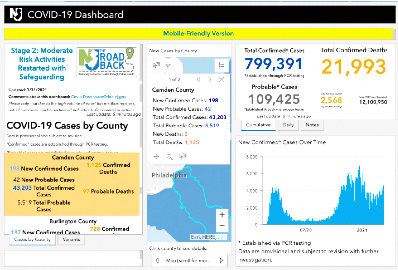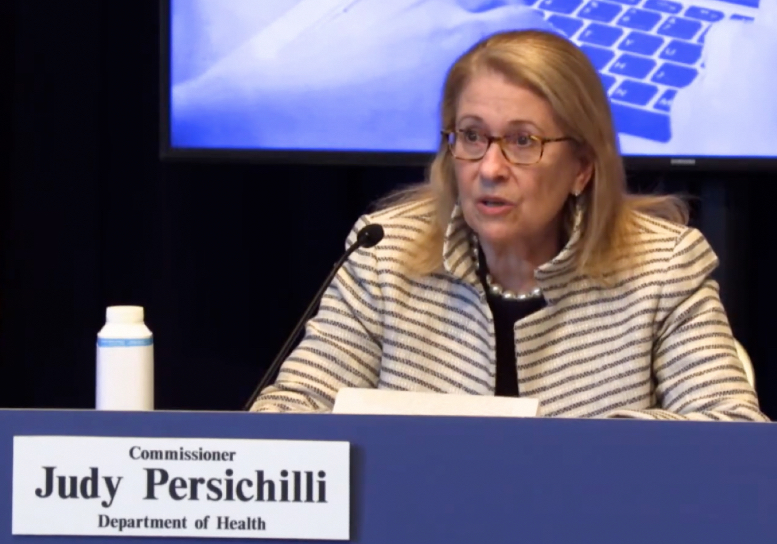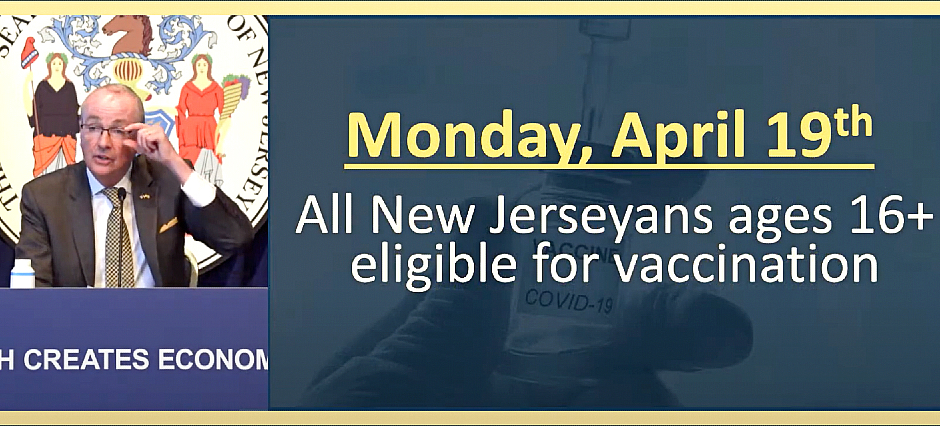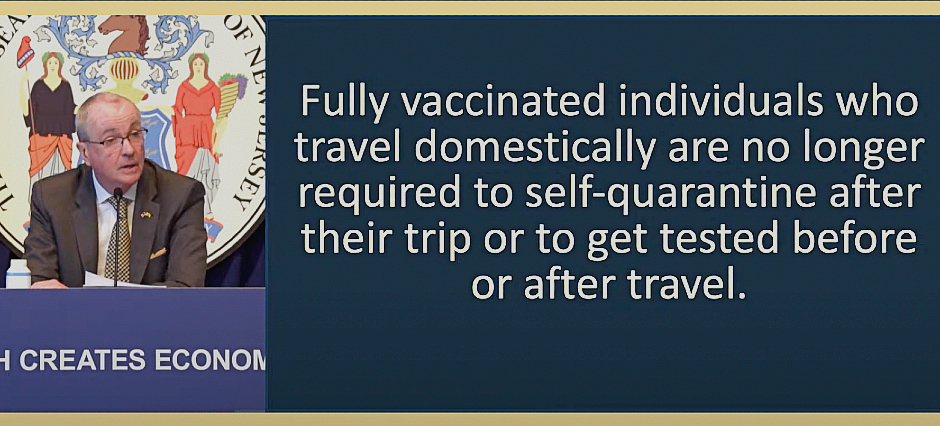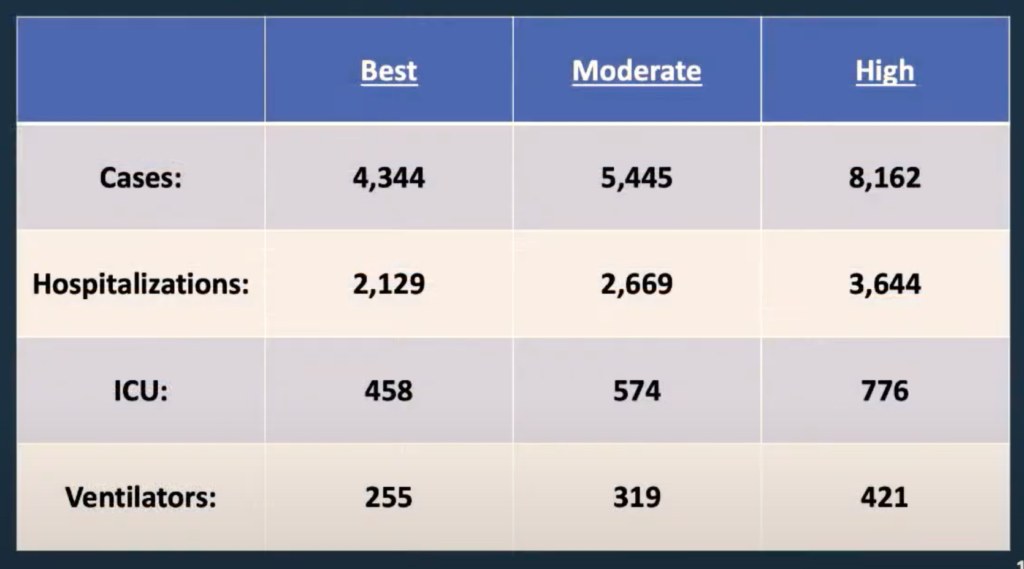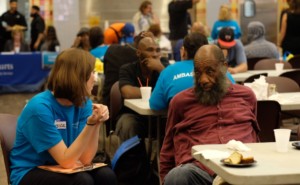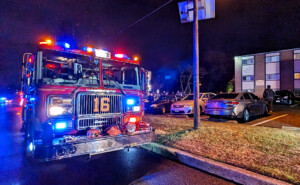Plus: Murphy outlines New Jersey’s best-case scenario for the spread of the virus over the spring and summer, and fully vaccinated people aren’t required to quarantine or test before domestic travel.
By Matt Skoufalos | April 5, 2021
Another 2,471 New Jersey residents have tested positive for novel coronavirus (COVID-19), bringing the statewide total to 817,464 cases confirmed via polymerase chain reaction (PCR) testing, Governor Phil Murphy reported Monday.
New Jersey is also reporting 513 new COVID-probable cases based on antigen tests, bringing the statewide total to 112,562 positive antigen tests.
Antigen tests have a faster turnaround time than PCR tests—sometime within 15 to 30 minutes—but are less reliable at detecting active infection of the virus and more capable of reporting false positives.
Sadly, 15 more residents have perished from complications related to the virus, bringing the statewide, confirmed death toll to 22,081 lives lost during the pandemic.
In addition to those lab-confirmed fatalities, the state has acknowledged another 2,568 probable COVID-19-related deaths.
Since March 2020, 788 of every 100,000 New Jersey residents have been hospitalized with COVID-19, and 251 of every 100,000 have died from COVID-19-related complications.
More than 12.237 million polymerase chain reaction (PCR) tests for COVID-19 have been performed statewide, with an 9.30-percent positivity rate per 100,000 residents.
Rate of transmission (Rt) at 1.07, spot positivity lowest in South Jersey
The statewide average of COVID-19 spot positivity testing based on PCR test results stood at 9.14 percent April 1; in South Jersey, it was lowest, at 8.53 percent.
Rt, the variable that describes the seven-day, rolling-average, statewide rate of transmission of new COVID-19 cases, hit 1.07 on April 3.
An Rt figure greater than 1.0 means that each new COVID-19 patient is infecting more than one other person, on average, and the spread of the virus is increasing.
Since its mid-April-2020 COVID-19 spike, the highest reported RT in New Jersey was 1.48, recorded August 1, 2020. The lowest was 0.62, recorded June 9, 2020.
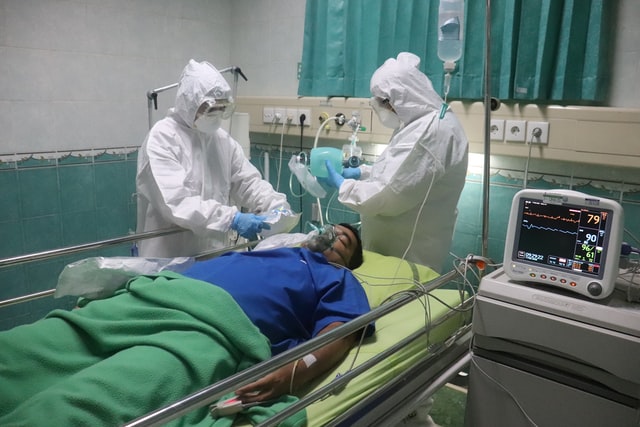
Simulated COVID-19 patient in a hospital bed. Photo by Mufid Majnun on Unsplash
Hospitalizations
Throughout New Jersey, 2,292 people currently are hospitalized with a suspected (110) or confirmed (2,182) case of COVID-19, Murphy said.
Among those hospitalized patients, 454 are in intensive or critical care, and 233 of the ICU and critical-care patients (51 percent) are on ventilators.
In New Jersey’s 71 critical care hospitals, 268 patients were hospitalized with COVID-19 yesterday, while 238 others were discharged.
LTC cases and counts
Across the state, long-term care (LTC) centers have reported 1,339 cumulative outbreaks of COVID-19, and 229 are dealing with an active outbreak. LTCs account for 54,141 infected patients and staff in New Jersey, or 6.2 percent of total cases.
That includes 32,540 residents and 21,601 staffers sickened by the virus, as well as 7,990 lab-confirmed resident and staff deaths (36 percent of the statewide confirmed total), with facilities self-reporting 143 staff deaths.
Of 656 veterans residing in three state-run homes, 439 residents have tested positive for COVID-19, and 220 have died from complications related to the virus.
Presently, four veterans are hospitalized with COVID-19; 300 have recovered from the virus.
At state-run psychiatric facilities, 346 of 1,127 patients and 1,002 staff members have tested positive for COVID-19. Fourteen patients and eight staffers have died from complications related to the virus.
MISC cases and schools
To date, 111 New Jersey children aged 1 to 18 have been diagnosed with pediatric multisystem inflammatory syndrome (MISC), New Jersey Health Commissioner Judy Persichilli said. Four of those cases were reported in Camden County, fifth-least in the state.
All those pediatric patients have tested positive for an active COVID-19 infection or the presence of COVID-19 antibodies, indicating exposure to the virus. No deaths have been associated with this syndrome in New Jersey, although several children have been hospitalized during their treatment.
Since August 1, 2020, 221 COVID-19 outbreaks encompassing 1,002 individual cases have been traced to schools in 19 New Jersey counties. In Camden County, 16 outbreaks have been linked to 74 cases, fifth-most in the state.
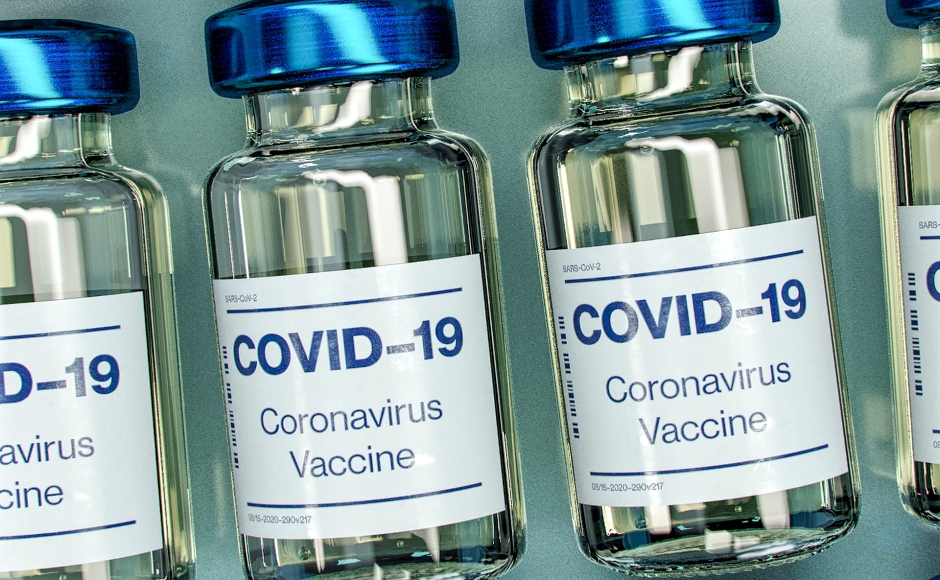
COVID-19 vaccine bottle mock-up. Photo by Daniel Schludi on Unsplash
Vaccination update
Across New Jersey, 4.701 million COVID-19 inoculations have been administered, 3.013 million of which are first doses.
Throughout the state, 1.796 million people are fully vaccinated, having received either a one-shot formulation from Johnson and Johnson or both doses of the two-shot Pfizer or Moderna vaccines.
In Camden County, 281,474 doses have been administered; seventh-most in the state.
The first vaccines in the state were administered December 15, 2020; by February 8—55 days later—New Jersey had immunized its millionth resident. Twenty days thereafter, that count hit 2 million, and 3 million within two more weeks. On March 29, New Jersey crossed the 4-million-dose threshold.
Persichilli noted that 75 percent of those New Jersey residents 65 and older have had at least one vaccine dose to date.
NJ records 645 cases of variants of concern
Mutated offshoots of COVID-19, or “variants of concern,” continue to circulate throughout New Jersey; Persichilli reported that the state has traced 645 such cases to date.
The most common COVID-19 variant in the United States is the B.1.1.7, or “UK” variant, which has been detected in all 21 New Jersey counties. In total, 627 B.1.1.7 cases have been spotted in the state.
New Jersey also has recorded eight cases of the P.1 “Brazilian” variant, two reports of the B.1.351 “South African” variant, eight reports of the California variant B.1.427 and two of the California variant B.1.429.
Cases have also been reported of strain B.1.526, which has been reported as originating in New York.
Roughly 2 percent of positive samples are being tested for variants, said Dr. Ed Lifshitz, head of the New Jersey communicable disease service, adding that state officials would like to increase testing to better be able to trace those variants.
All New Jerseyans 16 and older eligible for vaccine starting April 19
Today, vaccine eligibility expanded for several classes of New Jerseyans:
- Those 55 and older
- Those aged 16 and older with intellectual and developmental disabilities
- Higher education educators and staff
- Librarians and library staff
- Communications, IT, and press
- Real estate, buildings, and home services workers
- Retail financial institution workers
- Sanitation workers
- Laundry service workers
- Utility workers
In two weeks, however, the state will open up access to the COVID-19 vaccine to everyone 16 and older who wants to be scheduled for an immunization. That’s 12 days ahead of an initially planned date of May 1, Murphy said.
“We’re not suggesting that everyone who wants one has got one, but we want to make sure that we continue these overlapping waves, and we believe we can responsibly move that date up from May 1 to April 19 and make this available to anyone 16 and over,” he said.
Even after having been vaccinated, people are still required to wash hands, social-distance, wear masks in public, and adhere to pandemic protocols until the virus is fully eliminated.
“As long as there’s SARS-CoV-2 virus circulating in the community, unfortunately no one is going to be completely protected from getting COVID-19,” said state epidemiologist Dr. Christina Tan. “We simply don’t know about every single population. Probably about 18 percent of the adult population is fully vaccinated [nationwide], so we still have a way to go.”
Quarantine, tests no longer necessary for domestic travel among fully vaccinated people
In keeping with new guidance from the U.S. Centers for Disease Control issued Friday, fully vaccinated New Jerseyans are not required to self-quarantine before or after domestic travel, nor must they get a COVID-19 test before or after traveling.
A federal requirement for testing upon returning to the United States after international air travel remains in effect, however.
A person is considered fully vaccinated two weeks after having received their last recommended dose of vaccine, and travelers are still expected to follow COVID-19 precautions while away from home, including hand-washing, social distancing, and mask-wearing, Persichilli said.
Murphy compares best, moderate, worst-case scenarios for spring COVID surge
Last week, the governor outlined moderate and worst-case scenarios for the spread of COVID-19 across New Jersey in the spring and summer months, following assumptions of caseloads observed following holidays and in previous behavior patterns throughout the pandemic.
On Monday, the governor outlined a best-case scenario, as modeled by the New Jersey Department of Health, which assumes “everything we need to work in our favor does just that,” he said.
The best-case scenario assumes a similar rate of new cases following major holiday weekends, an adult population that is 70-percent vaccinated by June 1 with a 95-percent vaccine efficacy rate against COVID-19 variants.
Under this scenario, cases would peak at a daily rate of 4,344 around mid-April, with a steady decline throughout the summer. Hospitalizations would peak in mid-May at 458 ICU patients, 255 of whom are on ventilators.
In the moderate-case scenario, New Jersey would hit 5,000-plus new infections daily throughout April, with an April 18 peak of 5,445 new positive, 2,669 hospitalizations, and 574 ICU patients, 319 of which on ventilators.
In this model, daily new cases aren’t expected to fall to fewer than 3,000 until mid-June at earliest, and won’t go to less than 1,000 per day until August 2021.
“This feels to me closest to the reality we’re dealing with,” the governor said.
The high-case model makes many of the same assumptions, but also forecasts higher rates of infection after holidays, a stronger impact from COVID-19 variants, and only a 65-percent vaccine effectiveness. It presumes a higher rate of hospitalizations than seen in the past, plus broader community spread of the virus “as people lower their guard with the warmer weather,” Murphy said.
“We would basically be back to where we were in December and January, when the second wave was crashing down on us,” he said.
In the high-case scenario, New Jersey would see more than 8,000 new infections daily by mid-May and again in mid-June, with hospitalizations settling into the 3,500-patient range during that same time. ICU counts wouldn’t retreat until late July, with ventilators in high demand until late August.
Murphy said that New Jersey would hope for the best, but prepare for the worst, and noted, “those preparations do not mean in any sense that we can’t push ourselves down to the best-case scenario.
“Never forget, the power to end this pandemic rests on our collective shoulders,” he said. “We have already outperformed our models and crushed the curve twice before. Let’s do this a third and final time.”


